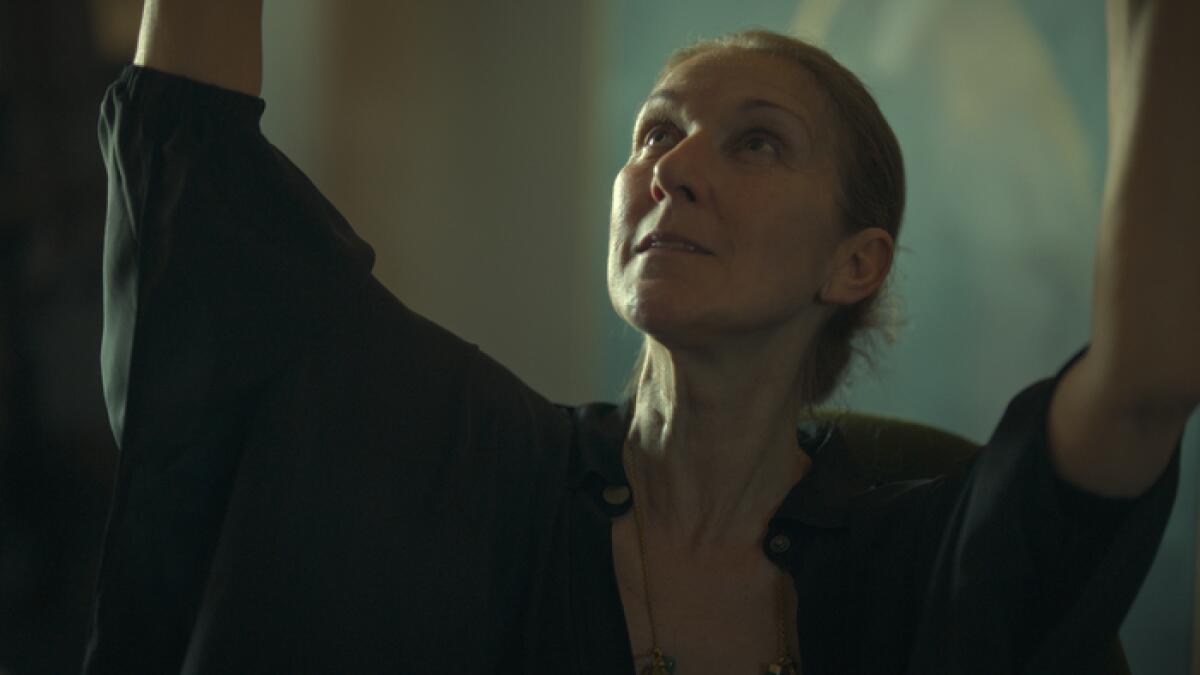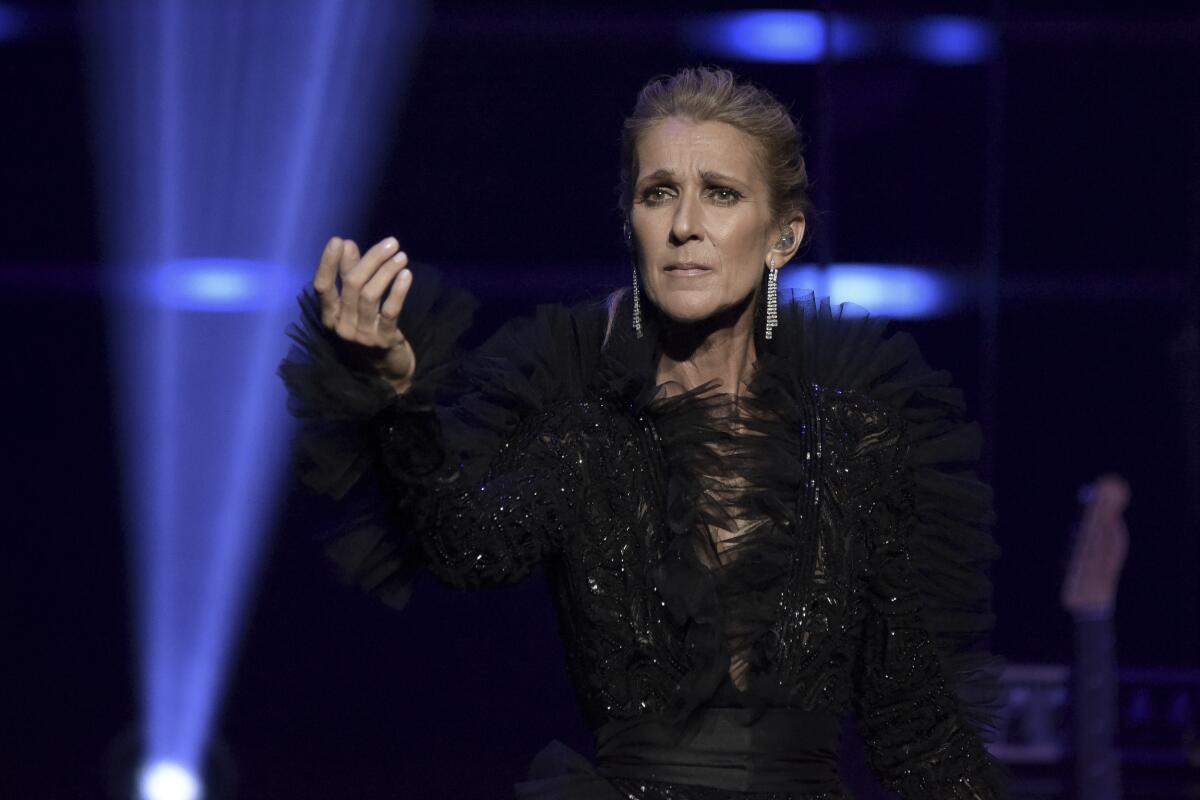“This is by far the biggest crowd I’ve had in a couple of years,” Celine Dion said onstage at Lincoln Center last week. She was making a rare appearance to introduce “I Am: Celine Dion,” a documentary chronicling her struggles with stiff person syndrome, a rare neurological disorder that causes muscle rigidity and makes it difficult for her to do what has most defined her since childhood: sing.
“I can’t believe how lucky I am to have my fans in my life,” Dion said, stopping to hold back tears as her son, René-Charles Angélil, waited on the side of the stage, handed him a tissue. “Thank you all from the bottom of my heart for being a part of my journey. This film is my love letter to each of you. I hope to see you again very soon.
Director Irène Taylor wasn’t exactly a Dion enthusiast when she received a call a few years ago asking if she would be willing to direct a film about the French-Canadian singer known for her powerful voice.
“Honestly, I didn’t think it would suit me. I don’t say this out of arrogance. I thought, “What would they want from me?” That’s not the kind of movie I make,” Taylor said in a video chat. His previous documentaries include the very personal “Moonlight Sonata: Deafness in Three Movements,” about his deaf son and father. She was eventually won over by Dion and tried to approach his subject “without peripheral vision,” Taylor said. “I really tried to look at the person in front of me and what was happening. »
The documentary, now streaming on Prime Video, uses performance clips and interviews from Dion’s 40-year career and traces the basics of her biography – starting with her childhood in Quebec, where she was the youngest of 14 children, then its crossed path. from the French-speaking teen star to a chart hit with power ballads like “Because You Loved Me” and “My Heart Will Go On.”
Blending archival material with contemporary footage of Celine Dion opening up about her health struggles, “I Am: Celine Dion” shows the singer at her most vulnerable, both emotionally and physically.
Gone is the glitz and glamor associated with his on-stage persona; Dion appears mostly makeup-free, dressed in casual attire, making goofy videos with her teenage twins. She proves endearing and crazy – at one point she breaks out into the Kit Kat jingle “Gimme a break” – but also self-aware and very funny, as when she delivers an impromptu monologue about her love of shoes.
She is also candid about the extent of her health problems, revealing in the film that she had been experiencing symptoms for 17 years at the time. What first manifested itself as occasional vocal strain became increasingly debilitating, forcing her to find ways to fake it on stage and cancel shows – something she, a performer with a zealous work ethic and dedication to his fans, found it almost as painful as the physical. condition itself.
The film shows us Céline Dion in the middle of a physiotherapy session, when she is struck by an episode of her illness. Lying on a table, she suddenly freezes. Although she can barely make a sound, her torn face conveys the agony she is experiencing. At the New York screening, audience members could be heard crying throughout the scene.

Director Irene Taylor on her approach to filming Celine Dion, shown in a scene from the documentary: “I really just tried to look at the person in front of me and what was happening.”
(Amazon MGM Studios)
Taylor followed Dion for about a year, spending several days with her per month, and found her to be courageous and authentic — qualities she hopes shine through in the film.
“She was down to earth with me,” she said, “so I just wanted to show the woman who showed me herself.”
Taylor spoke to The Times the day after the New York screening. The following conversation has been edited and condensed for clarity.
Did you know about his diagnosis when you signed up to make this film?
I wasn’t aware of his illness when I signed up for this. She hid it from the world, including me. It all made sense once I talked to him. I realized that this was a pretty devastating lie that she had been telling people for years. Her athletic qualities on stage did not suggest that she was ill. Yes, she was canceling some shows, but she found ways to pretend.
At first, I didn’t know what the film would be about. I didn’t really know what my opinion would be. I just knew it would be a portrait of her. She asked me: “Is it possible to make a documentary where no one else is present in the documentary, it’s just me?” This would seem very self-centered from a certain type of person, but it was a real question. I told him, “It’s definitely possible, but it will be a more difficult path for you because I need more of your time and I need your authentic self.”
But Céline was very direct with me. She never told me to stop filming. She actually said to me, “Don’t talk to me about whether you can do something or not, because it would bother me.” You are here in my house, you have carte blanche, do what you have to do. » This is a valuable tool to give to myself. She did not participate in the editing. She didn’t ask me to change anything. It’s a rare opportunity to be able to make a film about a public figure and to have so much freedom of action.
When did you learn about the disease?
I got a call asking if we could talk about it. It was a call between someone from the record company and a few people from her management team, and they basically said to me, “She’s not doing well, and we don’t have a name for it.” » There was no consensus on this. I had this information from the first day of filming, and then it was like a fire hose on me. “For seventeen years, I lied to everyone. I feel so guilty. » I was so overwhelmed that first day. I think she kept that to herself for a long time. For the first half of filming, I watched her struggle, not knowing what was wrong with her, and the doctors didn’t know what to do about it. Then, over time, there was a consensus, and she was very relieved when she received the diagnosis, even though it was an orphan disease. She told me, “I don’t want to have a rare disease. No one knows how to treat her. »
When she received that formal diagnosis, that’s when she wanted to tell the world, and she wanted to do it through Instagram — just tell people directly. So I changed the way I made films and decided how to fit it into the story in telling the world.

Irene Taylor said she was unaware that Celine Dion had been battling a debilitating illness for years when she began the documentary project.
(Richard Shotwell/Invision/Associated Press)
With celebrities and public figures, it can be difficult to get them out of their narrative. How did you find her as an interview subject?
I had reservations about making the film, because I saw “Céline Dion” in quotation marks, as a very cultured public figure. She had a character and I was a little cynical about it. I didn’t want to make a film about someone who had an agenda. It took being able to talk to him and then just connect with each other on a personal level about some personal things. We both love trees. We are both raising boys. She was very interested in sorting through everything that was (in the background) of our Zoom calls: “What is this? You could tell she was just trying to put me back together.
I had made very intimate films about people I know very well, like my parents and my son. I just didn’t know where she would fit. In the end, I realized that the fact that Céline was so accustomed to cameras, that she had lived her life under the light, made her a very authentic subject. I realized that instead of (her fame) being something to be wary of, it was actually working in my favor, but only because she had decided, ‘I have nowhere to go.’ She seemed to have it all. In fact, she was living a very private lie, and she called it a lie. I was amazed at the language she was willing to use to describe herself.
We see Dion I had this very intense episode, where it’s clear she’s in excruciating pain. Tell me about filming this episode. — what went through your mind?
All this happened in one minute. We were in a physiotherapy session. We were 10 minutes into two days of recording (his) music for the first time in several years. She left delighted, because she didn’t think she could do it. Ironically, it is this elation, this emotional state of mind, that can trigger this kind of response. We could have turned off the camera, but we had been filming for eight months now and Céline said, “Film everything.” I thought, “I have to make sure this woman is breathing,” so I just put my headphones in my ear, and I listened, and I couldn’t hear her breathing. I asked, “Is she breathing?” She was able to shake (the therapist’s) hand. I looked at my (cinematographer) and we continued.
I was actually grateful that about four minutes into the episode, you hear her therapist mention that the cameras are in the room and he’s checking in with her to make sure she’s okay. I wasn’t sure what she would say at that point, but she said she was okay. I couldn’t believe what had happened, and I was so grateful that she was okay, but I realized that this could be an opportunity, if Celine was up for it, to really show and really validate her pain.
Six months later, I showed him a rough cut of the film. I was very nervous. I knew I could never do this without his consent. She said: “I think this film will help me. » Then she said, “Don’t cut this scene. »
How has this project changed your perception of her? Are you now a fan, or at least an admirer?
A filmmaker must be very careful not to get carried away by anything. But I really let myself be inspired by her. We are almost the same age. I have my health and I observed someone who was really struggling. She finds so much joy in making music that she’s going to come out with something very powerful on the other side. Maybe it’s not Celine Dion who hit the tickets and basically does three aerobics classes at one concert. It can be a different intensity, a different artistic approach, a different way of playing. But I can tell you that she is very determined to defend the interests of people suffering from this disease.